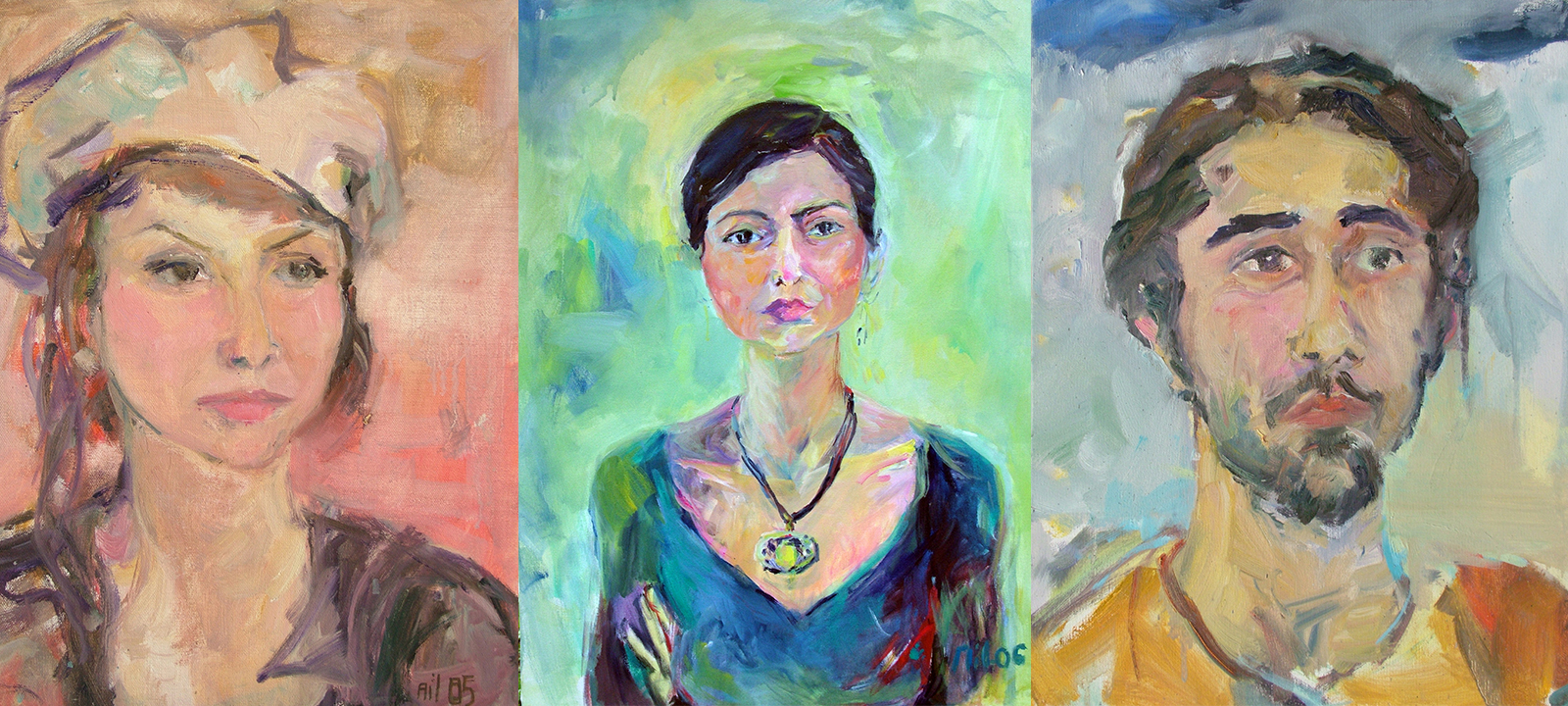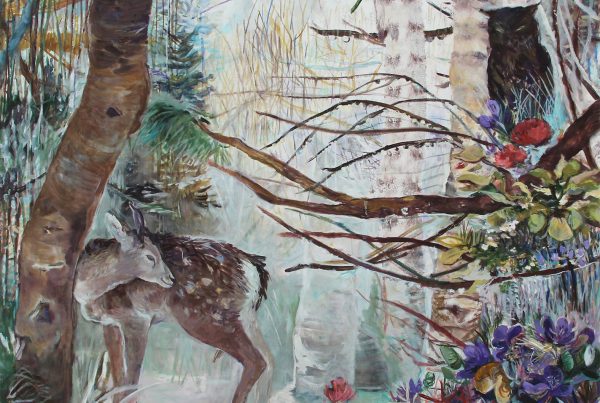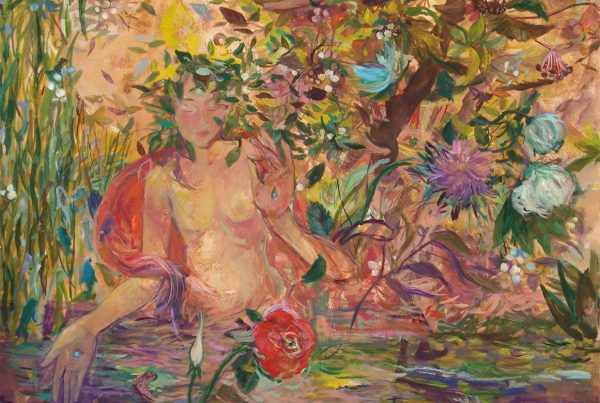ON NİL KÖKEN’S PORTRATURE
Dr. Hakkı Engin GİDERER
Can we recognize a person by just looking at his face? Can we reach the deep knowledge of acquaintance? Can we create a frame in our minds about the personality, worries and sincerity of the person sitting in front of us, his attitude towards life, his defeats and his passions as well? Psycho therapy sessions which are the most effective forms of acquaintance are full of innumerable hints. Therapist, by observing the looks, words, body language, voice, cloths and mimics of the person infront of him and that person’s walk from the door to his table, starts to collect information about this person. Most of this information starts to shape up in the therapist who volunteers to become an emotional and cognitive mirror. The lines, details, colors that are hidden to the eyes of the person are reflected back to him by the therapist, thus he can have a better view and awareness of him self, his mistakes and his positive qualities. Sometimes a therapist might not become a good mirror. And sometimes the person might never have the courage to face the mirror of the therapist.
Painter – if the model sat infront of him involuntarily when drawing a portrait- owns almost the whole facilities of the therapist. The model speaks to the painter, the expression in his eyes, his voice, body language, his cloths and mimics are totally at artist’s disposal. The words being spoken between the therapist and the patient are locked in the therapy room and stay there forever. On the other hand model of the painter knows that his portrait will be hanged on a wall and exposed to the eyes of others. Painter might not carry a worry to please the model. The relationship between the model and the painter –if the portrait is not a commission- is not as democratic as the relationship in the therapy. Painter is the authority. He is painting the picture for himself. If the model is not telling his secrets, if he is speaking very less, the job of the painter is much more difficult than of the therapist. Then he has to pierce through the model with his eyes and his intuition. The portrait painter forms a mirror to reflect the psychology of the model by composing many broken pieces, uniting hundreds of moments. All faces which are formed by the language of painting are the plateaus of the unknown, immortality and plural significance.
When do we decide that a portrait is good? When it truly reflects the personality of the model or when the reflections of the model are mixed with the psychology of the painter? Some portrait painters look at their own mirror more, as they give more importance to them selves (their art) more than the model. And some achieve to keep themselves away. In Holbein’s paintings, the cloths and the objects related to the profession of the model are as important as the portrait it self. In some paintings by Picasso, style covers the portrait. Some painters equalize the landscape behind the model with model’s face.
The portraits in Nil Köken’s first exhibition are the paintings of the people of her close environment. The boy and girl friends, her professors in the university, her father and her self; the people she loves, from time to time she has conflicts and disagree. When we start to paint the people that we know in life, we are luckier than the therapist in the effort of forming the mirror. In life we have the chance to recognize them through their relationship with the others. We have plenty of time to evaluate them. Although the therapy room is a denser atmosphere than the life it self, it is poorer with less experiences. The therapist never crosses the border of friendship, love and amity. He spends the time on forming a cool and perfect mirror. But while drawing the person we love, we use the passionate, exhilarated and free spirit of art which allows the love. The warmth in Nil Köken’s portraits reaches us even though we have no information about the identity of the models and their relations with the painter. For those who has this information, it is certain that the painter has grasped her models, both their out looks and psychology with a sharp gaze.
The back ground colors are related to the portraits. Back ground is not a theatrical setting but it creates an illusion of a more realistic space. We can say that portrait breath in this space. We as well may state that the painter uses a subjective dictionary of the psychological codes of these colors. Expressionist style, the quick movements of the brush, they all aim to transfer the captured reality to canvas as soon as possible with no distraction. Compared to the faces of the model, the plainer and less colorful treatment of the background enable the portrait approach forward and the attention to focus more on the portrait. Some objects which are used in the portraits are derived from her other paintings (paper ships, dolls, butterflies). The same childishness of the big canvases with fairytale atmosphere is especially seen at auto portraits. Magical, childish, poetic (the fusion of colors within each other, the insignificant and misty surfaces on which the lines diminish) expression, differentiate Nil Köken’s portraiture than the hard reality of photography. For this reason, we may say that Nil Köken’s portraits are narrations of an internal reality. The reason why her auto portraits are more impressive might be that in those portraits she was painting the person she knew the best. While painting auto portraits, the painter might waken up the model from his deepest sleep to start studying. He might force him to work with no eating pause or treat his model quiet pitiless. It means a great comfort for a painter to be the model of himself. It requires courage to reflect the information about yourself and your personality to the others. And the courage of the painter who is drawing his auto portrait determines the quality of the painting. We can say that Nil Köken has shown this courage in her own portraits. We meet the sincerity of the painter, infront of these uneasy, introverted, fragile faces; willing to go back to childhood and giving much importance to childish innocence.
Why does a painter choose the subject of portraiture? To bring up his impression about his model, to understand his own self that is present in the model, to eternalize the liveliness of his model, to compete with the other portrait painters, because he takes pleasure in looking at faces more than other things, to convey the mystery hidden in faces, to articulate himself to the others… I would like to know the reasons why Nil Köken has studied portrait so densely.




